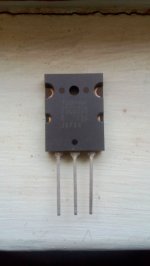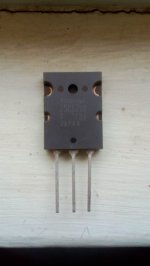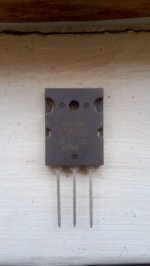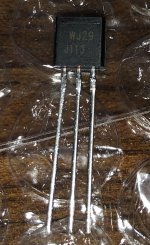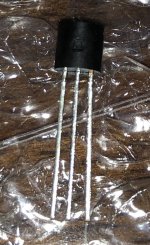Goodday All
i recently purchased 2sc5200 and 2sa1943 from a local supplier. i have some doubts on the authenticity of them given that the TTC and TTA versions are a better version of these parts. With the uploaded images, can we say these are genuine or fake parts? i need assistance because i have a class h amp where i need to use them on.
please note that the physical dimensions and weight of these are the same with the ttc and tta trannys i already have.
Thanks in advance.

i recently purchased 2sc5200 and 2sa1943 from a local supplier. i have some doubts on the authenticity of them given that the TTC and TTA versions are a better version of these parts. With the uploaded images, can we say these are genuine or fake parts? i need assistance because i have a class h amp where i need to use them on.
please note that the physical dimensions and weight of these are the same with the ttc and tta trannys i already have.
Thanks in advance.
Attachments
Those actually look real. Tested them yet? Just measure Cbe.
BTW - I wouldn’t actually consider the TTA/C versions “better”. Especially not for a big class H amp. The dies are smaller on the TT version - doesn’t affect the weight by anything significant. If the 2S’s are real Cbe will higher on them.
BTW - I wouldn’t actually consider the TTA/C versions “better”. Especially not for a big class H amp. The dies are smaller on the TT version - doesn’t affect the weight by anything significant. If the 2S’s are real Cbe will higher on them.
I was quoted $1.60 for a genuine pair here, 1943 / 5200.
The price difference is due to high wages and paper trails in the higher wage nations, it seems.
The price difference is due to high wages and paper trails in the higher wage nations, it seems.
goodday.Those actually look real. Tested them yet? Just measure Cbe.
BTW - I wouldn’t actually consider the TTA/C versions “better”. Especially not for a big class H amp. The dies are smaller on the TT version - doesn’t affect the weight by anything significant. If the 2S’s are real Cbe will higher on them.
i have not tested them in a circuit yet but the meter readings are as follows
c5200:
base-collector: 551
base-emitter: 553
collector-emitter: no reading
a1943
base-collector: 548
base-emitter: 552
collector-emmiter: no reading
my supplier here on average quotes them at $2.50. and for sure paperwork and shippingI was quoted $1.60 for a genuine pair here, 1943 / 5200.
The price difference is due to high wages and paper trails in the higher wage nations, it seems.
TTC prefix indicates the much cheaper, Chinese production of the original size 2-21F1A or TO264 package. These have been available for about 8 years already and the original Japanese products were replaced by TO3P versions marked 2SC5200N/2SA1943N. They are fine for most DIY construction despite smaller die size. According to Toshiba's website, the original 2-21F1A Toshiba package (i.e. similar to TO264) is now also available again too - if you don't mind buying through authorised suppliers and paying their premium prices.
As usual, beginners who don't realise that they're being ripped off just as bad, will choose the lowest price for unqualified components rather than pay premiums for genuine product. So it's really your problem (or maybe it just doesn't matter at the actual low power levels we use) if you wind up with fake semis that have something like TIP35/36 inside.
As usual, beginners who don't realise that they're being ripped off just as bad, will choose the lowest price for unqualified components rather than pay premiums for genuine product. So it's really your problem (or maybe it just doesn't matter at the actual low power levels we use) if you wind up with fake semis that have something like TIP35/36 inside.
Last edited:
I suspect these are milivolts instead of picofarads, aren't they?goodday.
i have not tested them in a circuit yet but the meter readings are as follows
c5200:
base-collector: 551
base-emitter: 553
collector-emitter: no reading
a1943
base-collector: 548
base-emitter: 552
collector-emmiter: no reading
Best regards!
Yes, you can't tell much about a transistor with a DMM or parts tester. The big issue with audio output transistors and drivers etc. is their current-gain linearity. So testing them requires a precision power supply, stable and strong signal source and 'scope, if you want to get serious. It's really much cheaper to buy the correct parts from a genuine parts source in the first place.
What some cant seem to comprehend is that in some parts of the world there is NO correct supplier. The entire available market is shades of gray. There was a time in the US where you couldn’t just order them from Mouser. They didn’t carry parts like this (but fakes weren’t rampant either). Getting genuine OEM parts was problematic. In some corners of the world it still is.
When they make fake 5200’s they don’t put in MJ15024, BUV21, or even 2N5631 dies. They put in the cheapest junk that will turn on. If you measure 5800pF or more it’s more than likely REAL. What goes in a fake will be about a third of that so they can be screened out - they are almost always some generic 50-100 watt epi-base type. Or the real thing. Tends to be No in between. If you want to go through the trouble of measuring linearity, fine. But usually unnecessary.
A vbe test tells you almost nothing - you do have to move beyond that.
When they make fake 5200’s they don’t put in MJ15024, BUV21, or even 2N5631 dies. They put in the cheapest junk that will turn on. If you measure 5800pF or more it’s more than likely REAL. What goes in a fake will be about a third of that so they can be screened out - they are almost always some generic 50-100 watt epi-base type. Or the real thing. Tends to be No in between. If you want to go through the trouble of measuring linearity, fine. But usually unnecessary.
A vbe test tells you almost nothing - you do have to move beyond that.
milivolts actually
I suspect these are milivolts instead of picofarads, aren't they?
Best regards!
Point taken but I can buy cheaper than traditional local agency prices here in OZ by ordering online from US distributors like Arrow, Mouser, Digi-key and others who may stock and distribute genuine parts from regional warehouses. I assume others who are obviously online here and already trading with credit cards etc. can do likewise from most countries. Here for example, Digikey and Mouser ship from Singapore so I assume they would also supply the broader SE Asia region from there. Yes, I do get genuine product in as little as a week, from Digi-key, Mouser catalog this way and I save a lot of cash by avoiding local distributor mark-ups which can be massive.What some cant seem to comprehend is that in some parts of the world there is NO correct supplier.
e.g. When first introduced, we were paying around US$12-18 retail for MJL series power transistors. Currently and in small quantities, local retailers still ask about US$10 each for MJL21193/94 and US$3.50 each for TTC5200/TTA1943. US global distributors though, are much more competitive.
For my money, I'd much rather spend around double the price for parts from a genuine source, than waste the cost of replacing with more cheap fakes, only to continue replacing them or fit genuine parts at some point. That goes for any country, anywhere on the globe, whether you do have genuine parts distributors but don't use them or only cheap local market sellers of fakes.
Last edited:
I have a recently purchased TTC5200 in front of me and the country of origin is Japan.TTC prefix indicates the much cheaper, Chinese production of the original size 2-21F1A or TO264 package.
Last edited:
That's weird...The title "JAPAN" on the transitor refers to the OEM (Toshiba) - not necessarily the location of the last place of manufacture.
Some relevant Toshiba history is at post #9 here via Google or other browser, at the DIY Audio link: 2SC5200 and TTC5200
A few considerations:
1) The transistor is marked "JAPAN" as well as a label on the anti-static bag from the distributor (country of origin: JAPAN).
2) The spec sheet shows "JAPAN" on the face of the transistor whereas nothing is shown for the Toshiba 2SC5200N.
3) According to ICforensics https://www.diyaudio.com/community/threads/2sc5200-and-ttc5200.233303/
"The new TT devices will only be diffused and assembled in Japan while the older 2S devices would be manufactured in China as well as Japan."
4) I have some Omron relays with the same part number (they also appear 100% identical) that came from different sources.
The relays from one source (US distributor) are marked "JAPAN" and the other that came from our CM in China are marked "CHINA".
do you have a simple test circuit i can use on these transistors?If you measure 5800pF or more it’s more than likely REAL. What goes in a fake will be about a third of that so they can be screened out - they are almost always some generic 50-100 watt epi-base type. Or the real thing. Tends to be No in between. If you want to go through the trouble of measuring linearity, fine. But usually unnecessary.
A vbe test tells you almost nothing - you do have to move beyond that.
Capacitance meter. Don’t need anything fancy, I’ve got a DMM with L and C functions. Actually, three of them.
For testing SOA I configure the DUT as a current source using a 15 volt supply to feed the base and size the emitter resistor appropriately. I’ve got a nice little SMPS brick I use for pretty much everything. Use a series diode to prevent misfortune to the supply if the DUT shorts. Turn up the collector voltage to get to desired Pdiss (Transformer, rectifier and a variac). A 50 volt 4 amp test is easy with typical amplifier-building parts on hand. Fakes will blow, real ones will hold. You’ll know in less than a second. I mount the DUT to a finned heat sink and place one set of fins in an ice bath. That will hold the temperature for a short test. When the DUT fails it takes out the fuse on the variac or the emitter resistor. Might throw pieces of transistor case, so keep it at a safe distance. This type of setup is very useful for determining which types are conservatively rated and which are not, or what a totally unknown type will do. I’ve done this more often for this than for screening fakes. The Cbe test screens most of them out before I ever get that far.
There was an app note from RCA back in the 70’s that describes a jig that was used to do this test. Essentially it was the same thing. But it had a circuit to detect the rapid decrease in Vbe associated with the onset of second breakdown, and would shut down collector power within a microsecond when it happened. The test was therefore non-destructive. But if it’s fake it doesn’t matter if you save it, right?
For testing SOA I configure the DUT as a current source using a 15 volt supply to feed the base and size the emitter resistor appropriately. I’ve got a nice little SMPS brick I use for pretty much everything. Use a series diode to prevent misfortune to the supply if the DUT shorts. Turn up the collector voltage to get to desired Pdiss (Transformer, rectifier and a variac). A 50 volt 4 amp test is easy with typical amplifier-building parts on hand. Fakes will blow, real ones will hold. You’ll know in less than a second. I mount the DUT to a finned heat sink and place one set of fins in an ice bath. That will hold the temperature for a short test. When the DUT fails it takes out the fuse on the variac or the emitter resistor. Might throw pieces of transistor case, so keep it at a safe distance. This type of setup is very useful for determining which types are conservatively rated and which are not, or what a totally unknown type will do. I’ve done this more often for this than for screening fakes. The Cbe test screens most of them out before I ever get that far.
There was an app note from RCA back in the 70’s that describes a jig that was used to do this test. Essentially it was the same thing. But it had a circuit to detect the rapid decrease in Vbe associated with the onset of second breakdown, and would shut down collector power within a microsecond when it happened. The test was therefore non-destructive. But if it’s fake it doesn’t matter if you save it, right?
On Semi and ST make many of their jellybean types at different fabs. The origin codes can and do vary. Sometimes there is a measurable difference, often quite large. But those types have barn door specs anyway so even from the same fab you might get that much variation. I’ve seen TIP devices with factor of two differences in Cbe. And it’s perfectly normal.3) According to ICforensics https://www.diyaudio.com/community/threads/2sc5200-and-ttc5200.233303/
"The new TT devices will only be diffused and assembled in Japan while the older 2S devices would be manufactured in China as well as Japan."
I bought On Semi J113 transistors locally from previously good shop.
When I opened package there was those suspicious transistors. Definitely non On Semi.
Google search of J113 with similar marking leads to Aliexpress / Alibaba..
Does anyone know who is the manufacturer of those transistors?
When I opened package there was those suspicious transistors. Definitely non On Semi.
Google search of J113 with similar marking leads to Aliexpress / Alibaba..
Does anyone know who is the manufacturer of those transistors?
Attachments
Fakes usually have shiny plating on the mounting surface and leads (like bright tin), compared to silver plating (dull) on the real ones. The letter print is also strong in fakes.
But this does not mean silver plated ones are really real, just to start. I bought a few SK162 fakes to break open and see. The shop salesman himself said those were fake. From outside the leads and mounting sides were very shiny. Regards.
But this does not mean silver plated ones are really real, just to start. I bought a few SK162 fakes to break open and see. The shop salesman himself said those were fake. From outside the leads and mounting sides were very shiny. Regards.
I speculate those are either J113 or similar transistor but from a Chinese manufacturer.
Not from ON Semiconductor.
I thought maybe someone knows who made them.
Not from ON Semiconductor.
I thought maybe someone knows who made them.
- Home
- Amplifiers
- Solid State
- Genuine or Fake parts
